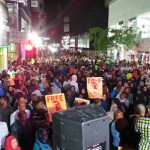From shoes, bags, and clothes made in Maldives, to locally grown fruits and vegetables – a variety of local products and services were on display at the “Dhivehinge Fannu” (Maldivian talents) exhibition organised by the Economic Ministry.
The three day exhibition opened at the Art Gallery on Thursday is part of the ministry’s efforts to promote local brands of goods and services.
“We wanted to bring the locally produced goods and services provided by Maldivian businesses and individuals under one roof” says Aminath Asma, Assistant Manager of Sales Marketing of Asaree Services, the event’s planner.
Around 20 different exhibitors including large and small businesses, non-profit organisations, and individuals are participating this year said Asma, adding that the Ramadan and Eid holidays had overshadowed their efforts to get parties to sign-up for the exhibition, affecting the number of participants.
“But, we are still happy with the turnout and in next two years we will increase efforts to get more businesses to join.” she added.
Taste of Maldives
The most successful stalls at the exhibition seemed to be the one’s displaying Maldivian tuna products.
Among other things, visitors had the chance to try out samples of barbecued tuna, crispy tuna sticks, and Rihaakuru – a traditional thick fish-based paste eaten by almost every Maldivian.
Next to the stalls of big fish processing companies such as MIFCO (Maldives Industrial Fishing Company), individuals running home-made businesses making small finger foods – mainly made from tuna – were also bravely marketing their products.
One of the ladies selling home-made Rihaakuru pointed to the jars on her table and said:
“Our Rihaakuru is much better than MIFCO’s products. Everyone knows it.”
At the exhibition Minivan News also came to learn about Maavahi island – an uninhabited island in the north where local vegetables and fruits are grown to supply both resorts and the domestic market.
A garden-like Maavahi stall displayed a wide range of fruits and vegetables including lettuce, chillies, pumpkins, dragon fruits, papaya, bananas, and mangoes.
Due to the geographical disadvantages of dry climate conditions and infertile soil, the Maldives has never had a large agricultural sector and almost all the food products – besides tuna – are imported for domestic consumption and resort supply.
According to the Maavahi stall manager, they have been using hydroponic technology and also fertilisers to increase their productivity and overcome the natural disadvantages.
“However, we still don’t have the production capacity to match the demand” the official pointed out.
Very “special” products
Among the exhibitors, two stalls run by the Ministry of Gender and Family and the Care Society of the Maldives also stood out. They displayed a collection of beautiful handicrafts and artwork including paintings and picture frames made by children and elderly people with special needs.
“It takes lot of handwork and time for the children to make these things,” said an official from Care Society, a non-government organisation supporting rights of special needs people and providing educational and training services.
Meanwhile, the lady at gender ministry’s stall noted that they did not have sufficient funds to market these “special products by special needs people”.
“So we mostly rely on exhibitions such as these to market and sell it,” she added.
Among other exhibitors, custom made shoes, bags, and slippers made by local company ‘Slippers’ were on display. According to the shop owners, they import leather, fur, and other raw materials before manufacturing the items in the Maldives.
Clothes, cakes, andcultural artifacts made by Maldivian’s were also items on display at the exhibition.





